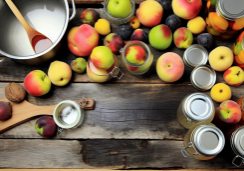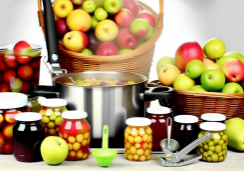Smoking Meats Simplified: Home Cook's Guide
In the days when smoke signals were the latest in communication technology, the art of smoking meats was already ancient history. Now, you've decided to tackle this time-honored culinary tradition in your own backyard. You're standing before your shiny new smoker, a selection of seasoned meats at your side, but the path from raw to ravishingly smoky is shrouded in mystery.
As a home cook, you understand that the key to mastery lies not in secret ingredients, but in the nuances of technique. You're about to embark on a flavorful journey, and with a little guidance, you'll transform ordinary cuts into smoke-kissed sensations. So, grab your tongs and thermometer—let's get the fire started.
Just remember, the secret to perfect smoked meats isn't just in the 'how', but also in the 'when' and 'why'—knowledge that's within your reach.
Selecting the Right Meat
When you're on the hunt for the perfect cut to smoke, aim for meats rich in marbling, as this fat weaves through the muscle, promising a melt-in-your-mouth tenderness and a depth of flavor that's hard to match.
Different types of meat bring their unique textures and tastes to your smoker, so consider your options carefully.
For instance, baby back ribs offer a classic choice that's both forgiving and delightful. These cuts of meat come with a natural succulence that's enhanced by the low and slow caress of smoke. Look for ribs with even thickness to guarantee that every bite is as perfectly cooked as the last.
When selecting your cut of meat, keep an eye out for an even distribution of fat. Too much and it won't render properly, too little and your smoked meats might end up dry. Freshness is key – fresh meat holds the promise of peak flavor. Don't be shy to ask your butcher for recommendations on the freshest cuts available.
Always consider size – it must fit comfortably in your smoker, allowing the smoke to circulate freely. Remember, the right cut isn't just about taste; it's about ensuring that every slice is a testament to your smoking prowess.
Essential Smoking Equipment
To embark on your smoking journey, you'll need the right tools, each as critical as the choice of meat to ensure mouthwatering results. Your essential smoking equipment begins with a reliable smoker, be it an offset, electric, or a versatile kettle grill. Understanding the ins and outs of your smoker is key, so choose one that suits your comfort level and space.
Next, arm yourself with a quality digital thermometer. Precision is paramount when smoking meats, and a thermometer ensures you're cooking at the right temperature. For those long smokes, a wireless meat thermometer might just become your best friend, allowing you to monitor the progress without lifting the lid and losing heat.
You can't forget about wood chips or chunks, the heart of flavor in the smoking process. Selecting the right type adds a new dimension to your meats, infusing them with a smoky richness that's irresistible. Keep a variety at hand, from hickory to applewood, to experiment with flavor profiles.
Tongs, heat-resistant gloves, and a sturdy meat injector round out your Beginners Guide to smoking must-haves. With this easy-to-follow guide to smoking and the right equipment, you're well on your way to becoming a pitmaster right in your own backyard.
Understanding Smoke and Temperature
Delving into the art of smoking meats, it's crucial that you grasp how smoke and temperature intertwine to create those tantalizing flavors and textures that elevate your culinary creations. The smoke, rich with complex compounds, infuses the meat with an irresistible aroma and a distinct taste that's synonymous with expert smoking.
As you embark on smoking meat, understanding smoke and temperature becomes your compass to excellence. Temperature control is the heartbeat of the process, ensuring that the smoke caresses the meat just right, without overpowering or underwhelming your palate. Managing the smoke levels is an art in itself, particularly as different woods impart their unique flavors. The type of wood you choose will whisper its own story into the fibers of the meat.
This book provides clear instructions and great insights into achieving the perfect balance. You'll learn to moderate heat to maintain the sweet spot where smoke can work its magic—melding flavor while tenderizing your cuts. Remember, too high, and you'll miss the mark; too low, and the concert of flavors won't quite reach its crescendo.
With patience and practice, you'll discover the symphony of smoke and temperature, transforming your homely fare into a smoky delicacy that's bound to impress.
Preparing Meats for Smoking
Having grasped the dance of smoke and temperature, it's time to focus on the equally important task of preparing your meats for smoking, starting with a thorough patting dry to ensure the perfect canvas for seasoning. This step is vital for achieving that delectable, crispy exterior that's the hallmark of perfectly smoked meats.
Before you're going to start the actual smoking process, here's what you need to do to prepare your meats:
- Trim any excess fat to enhance the meat's texture and ensure even smoking.
- Create a simple yet powerful dry rub using equal parts salt and pepper for a classic flavor foundation.
- Dry brine your seasoned meat in the fridge for a full day, allowing the flavors to penetrate deeply.
Imagine the anticipation as the salt and pepper work their magic, drawing moisture to the surface and promising a succulent feast. By learning how to smoke with precision and care, you're setting the stage for the best part of the experience: savoring the rich, complex flavors of your home-cooked smoked meats.
Properly examining the cut of meat ensures that you're starting with the best possible quality, guaranteeing a mouthwatering result after hours of gentle smoke.
Maintaining Your Smoker
Just as a chef sharpens their knives, maintaining your smoker is crucial for ensuring that your meats are infused with clean, flavorful smoke every time you cook. The key to succulent smoked meat isn't just a great book of recipes but a well-maintained machine.
Like any culinary tool, your smoker requires regular attention. Scrub the grates after each use to prevent old grease and debris from tainting your next batch of meats.
You also need to inspect seals and gaskets, replacing any that are worn to keep the smoke where it belongs: encircling your meats with that rich aroma. Seasoning the smoker isn't just about herbs and spices—it's about coating the interior surfaces to ward off rust and contribute to the overall taste profile of your smoked delicacies.
Don't forget to verify the accuracy of your smoker's temperature gauge. Precise heat is essential for the art of smoking meats.
Looking forward to your next cookout, ensure your smoker's home is dry and sheltered, or snug under a protective cover, safeguarding your investment and the promise of future flavor adventures.
Frequently Asked Questions
What Is the Easiest Meat to Smoke for a Beginner?
You'll find beef the easiest to smoke as a beginner, with its forgiving nature enhancing flavor profiles. Selecting cuts carefully, mastering temperature control, and allowing a proper resting period are key to success.
How to Smoke Meat for Dummies?
To smoke meat, you'll need to master wood selection, smoke timing, temperature control, flavor profiles, meat preparation, and cleaning smokers. It's a craft that'll turn your meals into mouthwatering, smoky delights.
What Type of Smoker Is Best for Beginners?
You'll find choosing smokers with electric starters, like propane or pellet types, best for beginners. They offer simple temperature control, consistent smoke flavor, and cleaning ease, all crucial for a smooth start.
How Do You Smoke Meat the Old Fashioned Way?
To smoke meat the old-fashioned way, you'll pick the right wood, master temperature control, and employ traditional curing methods. You'll generate rich smoke and understand marinating basics for that authentic, mouthwatering flavor.
Conclusion
Now that you've mastered the basics, it's time to revel in the rich, smoky flavors you'll create in your own backyard. Keep experimenting with different cuts and woods, and fine-tune those temperatures.
Your smoker isn't just a cooking device; it's your ticket to mouthwatering, fall-off-the-bone masterpieces. Embrace the process, share your succulent successes with friends and family, and most importantly, savor every smoky bite.
Happy smoking, and let the feasts begin!










